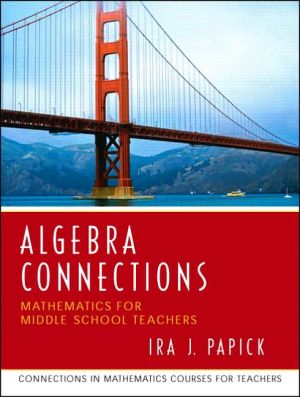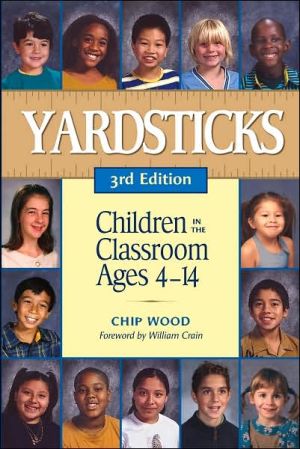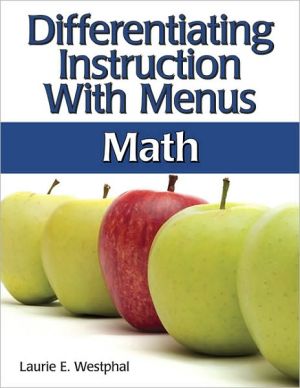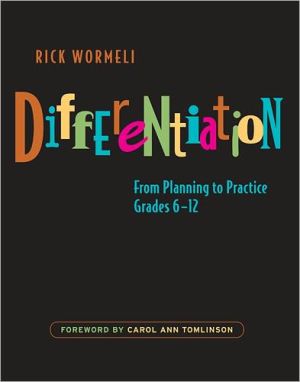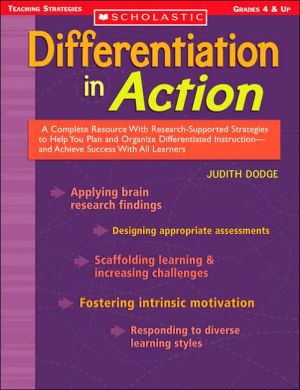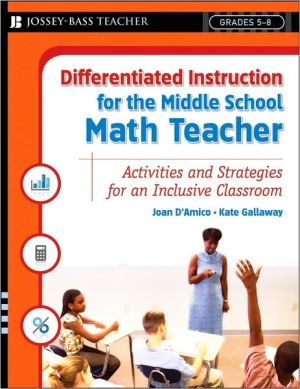Algebra Connections
Strong mathematics performance in the middle grades is more important than ever—and teachers entering the field need to prepare for this endeavor in new and innovative ways. This new approach introduces some basic concepts of number theory and modern algebra that underlie middle grade arithmetic and algebra, with a focus on collaborative learning combined with extensive in-class and out-of-class assignments. Gives both pre-service and in-service teachers a fundamental understanding of the...
Search in google:
Strong mathematics performance in the middle grades is more important than ever—and teachers entering the field need to prepare for this endeavor in new and innovative ways. This new approach introduces some basic concepts of number theory and modern algebra that underlie middle grade arithmetic and algebra, with a focus on collaborative learning combined with extensive in-class and out-of-class assignments.Gives both pre-service and in-service teachers a fundamental understanding of the key mathematical ideas that they will be teaching, so that in turn they can help their students learn important mathematics. Directly connects college-level abstract algebra and number theory to standards-based middle grade mathematics curricula. Gives specific examples from middle-grade curricular materials to show readers the direct connections between the mathematics they are learning and the mathematics they will be teaching. Focuses on the mathematics in new reform materials. Offers Classroom Problems and Classroom Discussions that focus on discovery and collaborative learning.A useful reference for teachers of middle-grades mathematics.
1. Patterns1.1 Classroom connections: Representing patterns1.2 Reflections on classroom connections: Representing patterns1.3 Arithmetic sequences1.4 Geometric sequences1.5 Mathematical induction1.6 Classroom connections: counting tools1.7 The Binomial Theorem1.8 The Fibonacci sequence2. Arithmetic and Algebra of the Integers2.1 A few mathematical questions concerning the periodical cicadas2.2 Classroom connections: multiples and divisors2.3 Reflections on classroom connections: multiples and divisors2.4. Multiples and divisors2.5 Least common multiple and greatest common divisor2.6 The Fundamental Theorem of Arithmetic2.7 Revisiting the lcm and gcd2.8 Relations and results concerning lcm and gcd3. The Division Algorithm and the Euclidean Algorithm3.1 Measuring integer lengths and the Division Algorithm3.2 The Euclidean Algorithm3.3 Applications of the representation gcd(a, b) = ax + by3.4 Place value3.5 Prime thoughts4. Arithmetic and Algebra of the Integers Modulo n4.1 Classroom connections: divisibility tests4.2 Reflections on classroom connections: Justifying the divisibility tests4.3 Clock addition4.4 Modular arithmetic4.5 Comparing arithmetic properties of Z and Zn4.6 Multiplicative inverses in Zn4.7 Elementary applications of modular arithmetic4.8 Fermat’s Theorem and Wilson’s Theorem ii4.9 Linear equations defined over Zn4.10 Extended studies: The Chinese Remainder Theorem4.11 Extended studies: Quadratic equations defined over Zn5. Algebraic Modeling in Geometry: The Pythagorean Theorem and More5.1 The significance of Daryl’s measurements and related geometry5.2 Classroom connections: The Pythagorean Theorem and its converse5.3 Reflections on classroom connections: The Pythagorean Theoremand its converse5.4 Computing distance in 2-dimensional and 3-dimensionalEuclidean space: The distance formula5.5 An extension of the Pythagorean Theorem: The law of cosines5.6 Integer distances in the plane5.7 Pythagorean triples: Positive integer solutions to x2 + y2 = z25.8 Extended studies: Further investigations into integer distance point sets - a Theorem of Erdös.5.9 Extended studies: Additional questions concerning Pythagorean triples5.10 Fermat’s Last Theorem6. Arithmetic and Algebra of Matrices6.1 Classroom Connections: systems of linear equations6.2 Reflections on classroom connections: systems of linear equations6.3 Rational and irrational numbers6.4 Systems of linear equations6.5 Polynomial curve fitting: an application of systems of linear equations6.6 Matrix arithmetic and matrix algebra6.7 Multiplicative inverses: solving the matrix equation AX = B6.8 Coding with matricesGlossary
